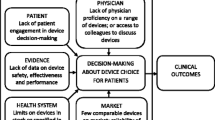Abstract
Purpose
This study aimed to identify themes associated with role conflicts and moral distress experienced by cardiovascular implantable electronic device (CIED) industry-employed allied professionals (IEAPs) in the clinical setting.
Methods
Focus groups were used to elicit perspectives from IEAPs who had deactivated a CIED.
Results
Seventeen IEAPs (five women) reported increased clinical presence and work-related role conflicts and moral distress along several themes: (1) relationships with patients, (2) relationships with clinicians, (3) role ambiguity, (4) customer service to clinicians, and (5) CIED deactivation. Patients often misperceived IEAPs as physicians or nurses. Many physicians expected IEAPs to perform clinical duties. Customer service obligations exacerbated IEAP role conflicts and moral distress because of dual agency. IEAPs commonly received and carried out requests to deactivate CIEDs; doing so, however, generated considerable distress—particularly deactivations of pacemakers in pacemaker-dependent patients. Several described themselves as “angels of death.” IEAPs had recommendations for mitigating role conflicts and moral distress, including improving the deactivation process.
Conclusions
IEAPs experienced role conflicts and moral distress regarding their activities in the clinical setting and customer service obligations. Health care institutions should develop and enforce clear boundaries between IEAPs and clinicians in the clinical setting. Clinicians and IEAPs should adhere to these boundaries.
Similar content being viewed by others
Abbreviations
- CIED:
-
Cardiovascular implantable electronic device
- FG:
-
Focus group
- HRS:
-
Heart Rhythm Society
- ICD:
-
Implantable cardioverter-defibrillator
- IEAP:
-
Industry-employed allied professional
References
Hayes, J. J., Juknavorian, R., & Maloney, J. D. (2001). The role(s) of the industry employed allied professional. Pacing and Clinical Electrophysiology, 24(3), 398–399.
Wilkoff, B. L., Auricchio, A., Brugada, J., Cowie, M., Ellenbogen, K. A., Gillis, A. M., et al. (2008). HRS/EHRA expert consensus on the monitoring of cardiovascular implantable electronic devices (CIEDs): Description of techniques, indications, personnel, frequency and ethical considerations. Heart Rhythm, 5(6), 907–925.
Mond, H. G., Irwin, M., Ector, H., & Proclemer, A. (2008). The world survey of cardiac pacing and cardioverter-defibrillators: calendar year 2005: An International Cardiac Pacing and Electrophysiology (ICPES) project. Pacing and Clinical Electrophysiology, 31(9), 1202–1212.
Lindsay, B. D., Estes, N. A., III, Maloney, J. D., & Reynolds, D. W. (2008). Heart Rhythm Society. Heart Rhythm Society policy statement update: recommendations on the role of industry employed allied professionals (IEAPs). Heart Rhythm, 5(11), e8–e10. Epub 2008 Sep 24.
Mueller, P. S., Jenkins, S. M., Bramstedt, K. A., & Hayes, D. L. (2008). Deactivating implanted cardiac devices in terminally ill patients: practices and attitudes. Pacing and Clinical Electrophysiology, 31(5), 560–568.
McCoy, F. (2003). More than a device: Today’s medical technology companies provide value through service. Cardiac Electrophysiology Review, 7(1), 54–57.
Krueger, R. A. & Casey, M. A. (2009). Focus groups: a practical guide for applied research (4th ed.). Los Angeles: Sage.
Clarke, A. (2005). Situational analysis: grounded theory after the postmodern turn. Thousand Oaks: Sage.
Strauss, A. L. (1987). Qualitative analysis for social scientists. Cambridge: Cambridge University Press.
Pope, C., Ziebland, S., & Mays, N. (2000). Qualitative research in health care: Analyzing qualitative data. BMJ, 320(7227), 114–116.
Lampert, R., Hayes, D. L., Annas, G. J., Farley, M. A., Goldstein, N. E., Hamilton, R. M., et al. (2010). HRS expert consensus statement on the management of cardiovascular implantable electronic devices (CIEDs) in patients nearing end of life or requesting withdrawal of therapy. Heart Rhythm, 7(7), 1008–1026.
The study was funded by a grant received by Dr Mueller, the Mayo Clinic Scholarly Opportunity Award.
Conflict of interest
Dr Mueller is a member of the Boston Scientific Patient Safety Advisory Board. He lectures for the Boston Scientific Education Services, and he is an Associate Editor for Journal Watch General Medicine.
Author information
Authors and Affiliations
Corresponding author
Rights and permissions
About this article
Cite this article
Mueller, P.S., Ottenberg, A.L., Hayes, D.L. et al. “I felt like the angel of death”: role conflicts and moral distress among allied professionals employed by the US cardiovascular implantable electronic device industry. J Interv Card Electrophysiol 32, 253–261 (2011). https://doi.org/10.1007/s10840-011-9607-8
Received:
Accepted:
Published:
Issue Date:
DOI: https://doi.org/10.1007/s10840-011-9607-8



